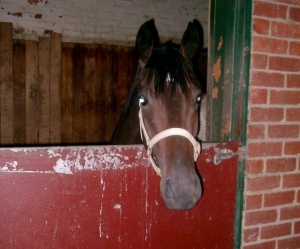Confinement
Like any intensive management system involving animals, the economic and efficient management of racehorses can profoundly compromise their welfare.

During training, most racehorses are kept for up to 22 hours per day in a stall about the size of a standard bedroom.
Such excessive stabling causes major disruption to a horse’s normal behavior, including its normal feeding patterns, resulting in both digestive and behavioural abnormalities. (1)
Horses like to move constantly and selectively graze for most of the day. (2)
Unable to socialize and move freely, many stabled racehorses will develop abnormal behaviours such as wood chewing, box walking (round and round the stall), windsucking (gripping an object with their teeth and sucking in air) and weaving (swaying the head, neck and forequarters from side to side).
Confinement also leads to several serious health problems endemic amongst racehorse, including stomach ulcers and respiratory disease.
Behavioural abnormalities can be reduced if horses are given more access to forage (such as hay), visual contact with other horses and the opportunity to graze naturally. In other words, opportunities to express more of their natural behaviour.
While there are still those who regard the “private life” of their stabled horses as being unimportant as long as it does not result in poor performance, others have begun to question the merits of traditional stable management techniques that push the horses beyond the limits of adaptation. (3)
1. Millos, 2005
2. Linklater et al., 2000
3. Paul McGreevy, BVSc, PhD, Equine Behavior. A Guide for Veterinarians and Equine Scientists, Saunders Ltd, 2004

